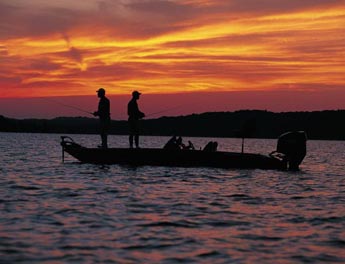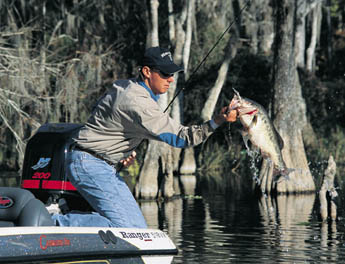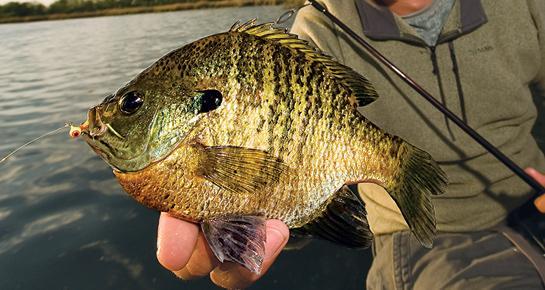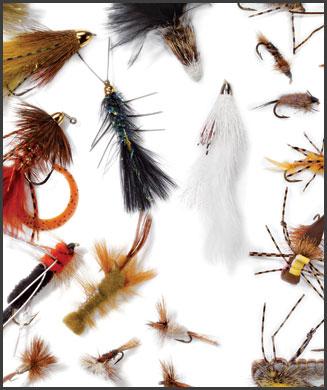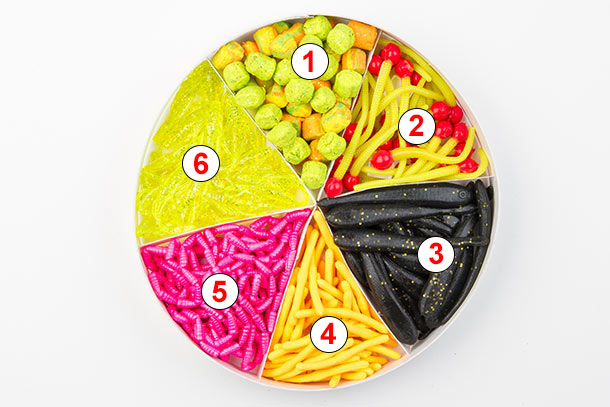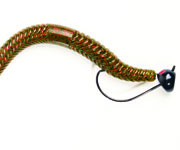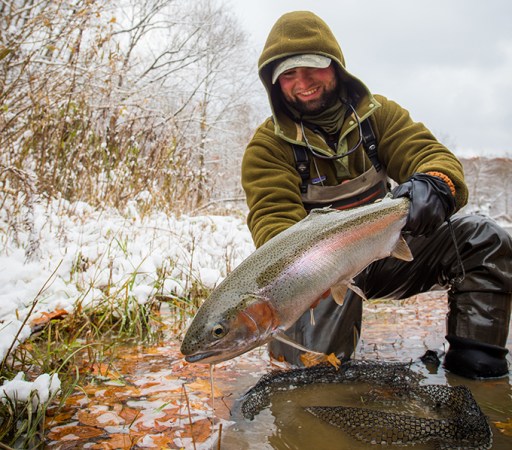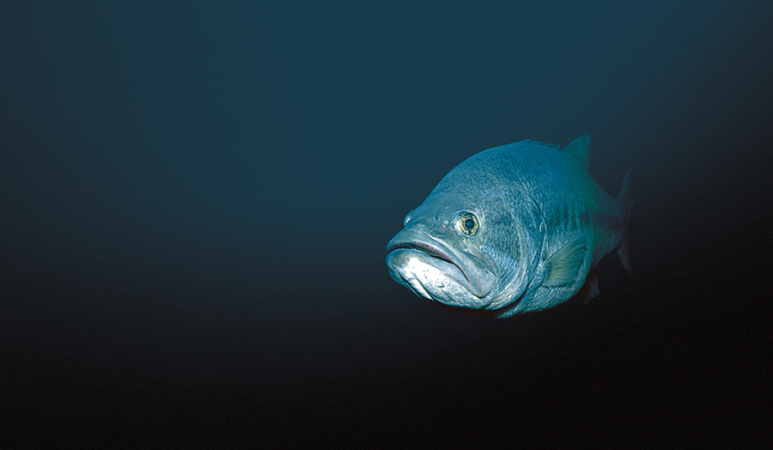Jigs and grubs will catch just about anything that swims. Bass fishermen use them to catch largemouths, smallmouths and spotted bass in an astounding array of water and cover conditions. They also take plenty of walleyes, northerns, muskies and striped bass.
Compared to crankbaits, spinnerbaits and most topwater plugs, jigs and grubs are simple lures with few moving parts; it’s angler skill more than their own built-in wobble and flash that makes them convincing targets for wary gamefish. If leadheads aren’t in your regular repertoire, it’s high time you familiarized yourself with these baits. Day in and day out, they’ll catch more and bigger fish than most other lure styles put together.
Head Gear
**Ball Head: **This design is a good choice for deep, clear lakes with little wood or weed cover. It falls quickly. Customarily used with twist-tail and shad-tail grubs, it is typically rigged with the hook point exposed.
**Toe-shaped Head: **Common on rubber- legged jigs, the toe-shaped head slides through thick cover better than other styles and is a favorite of bass pros, who often pitch or flip their jigs into dense vegetation and brush. The head is often equipped with a weedguard.
**Football Head: ** Designed to sink quickly for dragging across the bottom, this head is often paired with a plastic crayfish or twin-tail grub for probing deep offshore structure such as points and humps.
**Flat or Slider Head: ** This type of head is used when swimming (steadily reeling) small soft-plastic grubs, worms and shad bodies with an exposed hook. The flat design slows the lure’s descent so the angler can keep it moving with a steady retrieve.
Dart Head: Also called a bullet head, the dart head falls quickly. It’s often used for suspended fish and vertical presentations.
**Spinner Head: **This design features a small spinner blade above or below the head that flashes and vibrates as the lure sinks on a tight line or is hopped. It’s good for fishing schooling fish chasing baitfish.
[pagebreak] Delivery Systems
Casting will put jigs where you want them most of the time, but certain situations require special presentations:
**1. Pitching **is used to present jigs from a distance to difficult targets such as shallow weed patches, stumps and laydown logs, or under branches or boat docks. Using a stout 6½- to 7-foot bait-casting rod, release the spool and pull off one rod-length of line. Face the target and hold the jig in your free hand, about even with the reel. Lower the tip of the rod toward the water, then snap it upward quickly while letting go of the lure. The jig will move toward the target, pulling line from the reel as it travels just above the surface. Lowering the rod and thumbing the spool will help brake the lure for a softer landing and avoid backlash. Once the lure enters the water and falls, engage the spool and work the jig over or through the cover with the rod tip.
2. Flipping is a vertical presentation used to reach fish holding in dense subsurface weeds or brush, or beneath matted vegetation. Typically, the target is close. Using a heavy-action flipping stick, disengage the reel spool so the jig drops and pulls out about 8 feet of line. Pull another arm’s length of line off the spool with the free hand, then engage the reel spool. Pull the line while lifting the rod to 1 o’clock; the jig will swing toward you. Then lower the rod slowly to make the jig swing forward toward the target. Gradually lower the rod while feeding line back through the rod guides with your free hand. When the lure lands on the target, lower the rod and “feel” the jig down through the cover. When it stops, bump the rod tip gently to shake and hop the jig in place.
[pagebreak] Retrieve Tricks
**Swimming **is a technique th can be used with all jig and grub styles, for all types of fish. The idea is to reel the lure slowly and steadily just off the bottom so it resembles a live crayfish or a minnow. Make a long cast past the target and allow the jig to settle to the bottom. Lower the rod to 9 o’clock, then pop the tip to 10 o’clock while reeling slowly and steadily.
Pumping, which requires the angler to alternately reel and pump the rod in a steady retrieve, is a variation frequently used when fish are suspended.
**Hopping **a jig often triggers a reaction strike from sluggish gamefish. Cast and let the lure sink to the bottom. Lower the rod tip to 9 o’clock, reel up slack line and then pop the rod sharply to 10 o’clock, causing the lure to hop off the bottom like a crayfish. Repeat, alternately lowering and popping the rod upward. Causing the jig to hop more forcefully with a more rapid rod stroke is called darting.
**Tight-lining **works when pulling a jig or grub down a sloping bank or ledge. It’s a good technique in early spring when bass are beginning to move shallow but are too sluggish to chase a fast-moving lure. Following the cast, when the jig hits bottom, lower the rod tip to 9 o’clock and reel up slack. Then slowly lift the rod to 11 o’clock, dragging the jig along the bottom. Pause for a moment, perhaps shaking the jig in place; then lower the rod back to 9 o’clock and repeat.
[pagebreak] Different Looks
Rubber-legged jigs are used mainly by bass anglers to probe weed and wood cover on or near the bottom. Jigs that weigh ¼- to 5/8-ounce and have soft-rubber or synthetic skirts, a stout hook, a weedguard and perhaps a rattle are the most popular styles. These jigs should be paired with a trailer, usually a pork or soft-plastic frog (a.k.a. “jig and pig”) or crayfish. Fish them on 14- to 30-pound-test mono or heavier braided line with a 6½- to 7-foot medium-heavy bait-casting rod or flipping stick.
Bucktail jigs have a skirt made of natural or synthetic hair. They’re less bulky than rubber-legged jigs and are especially deadly in cold, clear water and swift current. The most popular sizes are 1/8- to 5/8-ounce. Bucktail jigs are often fished without trailers. Fish smaller bucktails on a stiff 6-foot spinning rod with 6- to 8-pound-test line; use a 7-foot medium-heavy bait-casting outfit and 14-pound-test line for heavier bucktails.
Spider jigs usually are paired with a soft-plastic twin-tail grub trailer and have a skirt or collar at the head. Best used for probing weedy cover; also deadly on reservoir points and humps at night. Fish a 3/8- to 5/8-ounce spider jig on a 7-foot medium-heavy bait-casting rod with 14- to 20-pound-test monofilament.
Pro’s pointer: “Use a slow, steady retrieve to swim a jig and pig down a laydown tree,” says Arkansas bass pro Ron Shuffield. “It will nail bass suspending in the branches.”
**Pro’s pointer: **”Pop a white bucktail repeatedly off the bottom on underwater humps and points to provoke a reaction strike from deep bass,” suggests Kentucky bass pro Dan Morehead.
Pro’s pointer: “A spider jig works best when it’s crawling across the bottom like a crayfish,” says Tennessee luremaker Stan Sloan. “Use the reel handle to move the bait.”
[pagebreak] Design Elements
The key component of every jig or grub is the head-basically nothing more than a weight molded around a hook. Traditionally, jigheads have been made of lead, but in recent years manufacturers started moving away from lead-based fishing tackle due to issues of toxicity. (Lead sinkers and lures are banned in Maine, New Hampshire and New York, and similar restrictions are under consideration in other states.) No problem, though; tungsten has proven to be a suitable substitute for lead in jigheads, albeit more expensive.
Head shape is an important, but often overlooked, factor in jighead selection. Shape helps to determine such characteristics as the weedlessness of the jig or grub, its rate of fall and its ability to crawl over rocks and through wood cover without hanging up in rock crevices, split stumps or submerged tree branches.
The line-tie, and where it’s mounted, is another design factor to consider. The position of the line-tie helps to determine a jig’s capacity to crawl through cover, as well as the effectiveness of point penetration when you set the jig’s hook.
Many bass-fishing jigheads have a vertical line-tie, which is poised atop the head so the jig drops horizontally, which is more natural looking. Other jigheads have a line-tie closer to the nose, which enables them to slide through aquatic vegetation better, though they fall through the water in a different angle of presentation.
Weedguards are commonly used with jigheads. Most bass jigs have fiber weedguards, while heads used with grubs may have wire weedguards. A head with no weedguard is preferred when you’re fishing open water where hangups aren’t a problem. To varying degrees, weedguards can inhibit hooksets.
Rattles are often used with rubber-legged bass jigs to help the fish locate the lure in muddy or weedy conditions. Some jigs have a separate rattle cylinder attached to the hook shaft; others feature a hollow chamber in the head into which rattles are inserted during the manufacturing process. [pagebreak]
Grub Options
Twist-tail or curly-tail grubs feature a short, plump body and a single corkscrew tail. When the lure drops or is reeled straight in, the tail ripples enticingly. Rig it on a 1/8- to 3/8-ounce head and fish it on a medium-heavy 6-foot spinning outfit with 6- to 10-pound-test line, targeting gravel flats, sloping rock banks and points. Best colors: smoke, chartreuse and pumpkin.
**Twin-tail grubs **have two curly tails attached to a round body. Use them in murky water where more attraction is desired, and in river current. Fish a twin-tail on a ¼- to ½-ounce head with either spinning or bait-casting gear.
Spade-tail grubs closely resemble baitfish when darted and hopped. Rig them on ¼- to 3/8-ounce heads, and use a medium-action 6½-foot spinning rod and 8-pound-test line. Highly effective when bass are feeding on the surface: Cast to breaking fish, let the lure drop a few feet, then alternately hop and dart the grub quickly.
**Shad-tail grubs **have a blunt tail that pulses and vibrates on retrieve. The body is often shaped like a minnow. They’re best fished in river current on a ¼- to ½-ounce head using a hopping or darting retrieve.
- Pro’s pointer: “Shad-tails are great smallmouth lures in fast current,” says Pickwick Lake (Ala.) gu Head shape is an important, but often overlooked, factor in jighead selection. Shape helps to determine such characteristics as the weedlessness of the jig or grub, its rate of fall and its ability to crawl over rocks and through wood cover without hanging up in rock crevices, split stumps or submerged tree branches.
The line-tie, and where it’s mounted, is another design factor to consider. The position of the line-tie helps to determine a jig’s capacity to crawl through cover, as well as the effectiveness of point penetration when you set the jig’s hook.
Many bass-fishing jigheads have a vertical line-tie, which is poised atop the head so the jig drops horizontally, which is more natural looking. Other jigheads have a line-tie closer to the nose, which enables them to slide through aquatic vegetation better, though they fall through the water in a different angle of presentation.
Weedguards are commonly used with jigheads. Most bass jigs have fiber weedguards, while heads used with grubs may have wire weedguards. A head with no weedguard is preferred when you’re fishing open water where hangups aren’t a problem. To varying degrees, weedguards can inhibit hooksets.
Rattles are often used with rubber-legged bass jigs to help the fish locate the lure in muddy or weedy conditions. Some jigs have a separate rattle cylinder attached to the hook shaft; others feature a hollow chamber in the head into which rattles are inserted during the manufacturing process. [pagebreak]
Grub Options
Twist-tail or curly-tail grubs feature a short, plump body and a single corkscrew tail. When the lure drops or is reeled straight in, the tail ripples enticingly. Rig it on a 1/8- to 3/8-ounce head and fish it on a medium-heavy 6-foot spinning outfit with 6- to 10-pound-test line, targeting gravel flats, sloping rock banks and points. Best colors: smoke, chartreuse and pumpkin.
**Twin-tail grubs **have two curly tails attached to a round body. Use them in murky water where more attraction is desired, and in river current. Fish a twin-tail on a ¼- to ½-ounce head with either spinning or bait-casting gear.
Spade-tail grubs closely resemble baitfish when darted and hopped. Rig them on ¼- to 3/8-ounce heads, and use a medium-action 6½-foot spinning rod and 8-pound-test line. Highly effective when bass are feeding on the surface: Cast to breaking fish, let the lure drop a few feet, then alternately hop and dart the grub quickly.
**Shad-tail grubs **have a blunt tail that pulses and vibrates on retrieve. The body is often shaped like a minnow. They’re best fished in river current on a ¼- to ½-ounce head using a hopping or darting retrieve.
- Pro’s pointer: “Shad-tails are great smallmouth lures in fast current,” says Pickwick Lake (Ala.) gu
